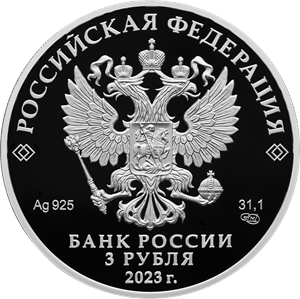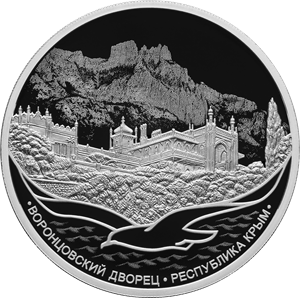Vorontsov Palace, Republic of Crimea
Obverse
a relief image of the National Coat of Arms of the Russian Federation and a semicircular inscription above it along the rim ‘РОССИЙСКАЯ ФЕДЕРАЦИЯ’ (RUSSIAN FEDERATION) framed with paired diamonds on both sides, under the coat of arms are the chemical symbol of the metal and fineness on the left and fine metal content and the mint trade mark on the right, at the bottom in the centre, in three lines, are an inscription ‘БАНК РОССИИ’ (BANK OF RUSSIA), the coin denomination ‘3 РУБЛЯ’ (3 RUBLES), and the year of issue ‘2023 г.’ (2023).
Reverse
a relief image of the Vorontsov Palace and park against the background of an image of the Ai-Petri Mountain, laser treated for matte finishing; a silhouette of a seagull flying over the sea waves, designed in relief, below; and the inscriptions framed with dots around the lower circumference ‘ВОРОНЦОВСКИЙ ДВОРЕЦ’ (VORONTSOV PALACE) and ‘РЕСПУБЛИКА КРЫМ’ (REPUBLIC OF CRIMEA).
Authors
Designers: E.V. Kramskaya (obverse), S.V. Sutyagin (reverse).
Sculptors: A.A. Dolgopolova (obverse), A.N. Bessonov (reverse).
Mint: Saint Petersburg Mint (СПМД).
Edge: 300 corrugations.
Discover more
The Vorontsov Palace rising above the Black Sea in Alupka and surrounded by a magnificent park is one of the most famous and unusual architectural monuments of Crimea.
The palace in Alupka is an architectural masterpiece of romanticism. Its construction lasted for nearly 20 years, from 1828 to 1848. The palace was built for the powerful Governor-General of the Novorossiysk Territory, aristocrat and anglomaniac Count Mikhail Vorontsov. The Count chose the location for his Crimean residence on the marvellous stone cape at the foot of the Ai Petri Mountain in Alupka, a little-known Tatar village. The royal architect of the British Empire Edward Blore, who designed a castle for Walter Scott in Scotland, ideally blended the palace into the landscape. Blore’s design of the Vorontsov Palace combines the English, neo-Moorish and Gothic architectural styles and the elements of that epoch when Walter Scott’s novels and oriental fairy tales were trending.
The palace is angled so that it repeats the shape of the mountains around it. Surprisingly, the architect who perfectly fit the palace into the landscape had never been to Crimea and was only guided by multiple nature sketches and terrain drawings sent to England for him.
The palace could be a perfect visual for historical novels: five buildings, fortified with defensive towels of various forms and heights, are connected by multiple open and close crossings, ladders and enclosed courtyards.
The palace was built of diabase, a local greenish-grey rock mineralogically resembling basalt that was supplied from the placer deposits in Alupka. It took a lot of effort to process the rock as even one inaccurate move with a drove chisel could damage the sophisticated decorations of the exterior. Therefore, the most complicated stone cutting work was done by the Russian stonecutters who had built white-stone churches in central Russia.
This was one of the first Russian palaces equipped with a hot water conduit and a sewage system.
The English park around the palace was laid out by the German gardener and botanist Karl Kebach invited by Mikhail Vorontsov to Crimea in 1824 when the palace had not been designed yet. He zealously started to create the park, paying attention to the terrain, climate and local flora, while combining them with the latest landscape architecture achievements. Nearly 200 species of trees and bushes were delivered from all over the world. Parcels with seeds and young plants were supplied from the Caucasus, China, Italy, Japan, Karelia, and the USA.
Karl Kebach designed the park as an amphitheatre. The coastal highway (Yalta–Simeiz) runs through the park dividing it into the upper and lower parts. The lower park is decorated in the style of Italian Renaissance gardens with fountains, marble sculptures, Byzantine columns, vases and stone benches. The upper park is designed as more natural and genuine English landscape parks of the Romantic period: rock fragments, shady ponds and wild sections of the Crimean forest are combined with picturesque lawns and a unique system of lakes, waterfalls, cascades and grottoes.
A carefully designed drain system and individual plant care ensured the desired result: many plants, even very rare and sensitive species, took root. By the end of the 19th century, there were 250 species of trees and bushes in the park. The flora of the Vorontsov park was so popular that young plants were even sold to owners of other gardens and manors.
The reputation of the Vorontsov park as a masterpiece of landscape architecture was solidified by the artists who made the sketches for the palace, including Isaac Levitan, Vasily Surikov, and Aristarkh Lentulov. The parks, gardens and vineyards owned by Count Vorontsov and his relatives, the Naryshkins and Pototskys, transformed the view of the coast from Alushta to Foros.
Source: https://www.culture.ru


